#BrachyCares ‑ For the climate, and for the world - PDF Version
The Polish Society of Brachytherapy has started a unique project in oncology: it aims to educate patients and their families holistically by increasing awareness of the relationship between environmental quality and cancer incidence.
To formalise our concepts, we decided to change our travel habits to the annual European SocieTy for Radiotherapy and Oncology (ESTRO) conference. As you know, it is a very important place to exchange scientific experiences and ideas for the further development of brachytherapy, and thus for better care of cancer patients. This year, the annual ESTRO conference was held between 6 May and 10 May in Copenhagen, Denmark. It is customary for each participant to travel to the site by plane. Instead, we went on the sailing yacht (s/y) Passie. Thanks to this, our eight-person crew left a carbon footprint 12 times smaller than if we had flown, approximately speaking – 300 kg of CO2, instead of 3.5 tonnes.
We left Kołobrzeg, Poland, on 3 May to reach Copenhagen on 5 May. The crew consisted only of radiation oncologists. Our message was simple:
“Climate change and cancer are related. Not every person is aware of their responsibility for environmental pollution that affects their health. What is happening around us is important. “
We believe that even small changes in everyday life combined with the continuous pro-environmental education of the general public can help our planet and at the same time reduce cancer incidence.
Ship's logbook s/y Passie Baltic Race 2022 #BrachyCares by Piotr Wojcieszek
3 May 2022
Our crew is complete. Every team member has reached Kołobrzeg Marina safely and has embarked on our boat s/y Passie.
Crew list:
.jpg.aspx)
Skipper - Piotr Wojcieszek, MD, PhD
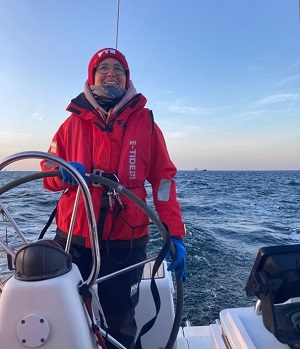
First officer - Magdalena Stankiewicz, MD, PhD
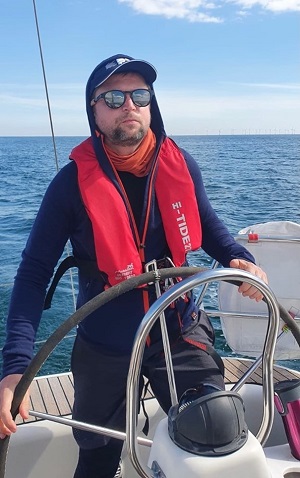
Second officer - Marcin Hetnał, MD, PhD
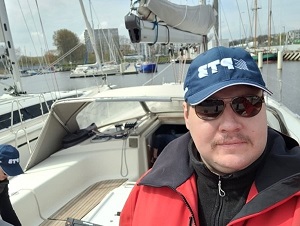
Third officer - Marcin “Włodi” Włodarczyk, MD
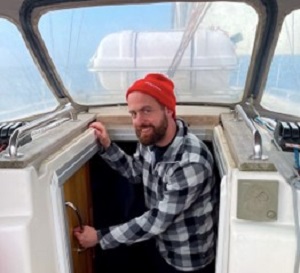
Cook and boatswain - Artur J. Chyrek, MD, PhD
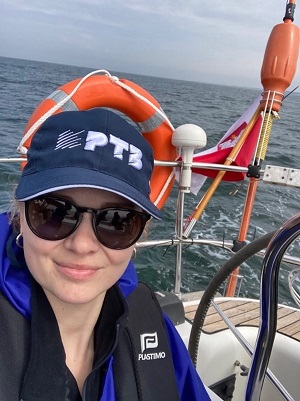
Medic and sous-chef - Małgorzata Jankowska, MD
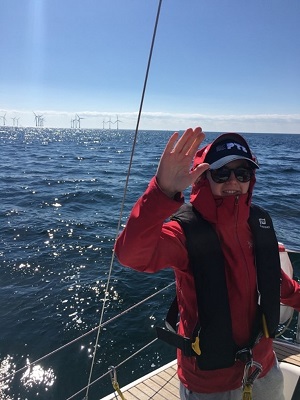
Deckhand - Anna Bandurska-Luque, MD, PhD
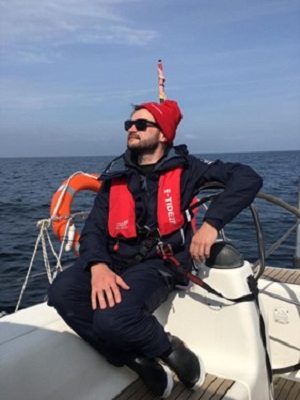
Radar operator and deck hand - Piotr Lelek, MD
15:00 central European time (CET): I give an order to prepare to leave the port. The weather forecast is good. I ask on VHF Channel 12 (Kołobrzeg harbourmaster's office) for permission to leave the port. I start the engine. Slow ahead, and we leave our mooring position.
15:15 CET: We pass through the Kołobrzeg port entrance. We are at sea.
15:45 CET: I order the crew to set the sails. We begin to sail upwind, port tack. Our course is NNE. Waves are about 1m high. My crew experiences mild sea sickness, but they're brave.
19:30 CET: Wind calms down. The Baltic Sea looks like a table. I order the crew to douse the sails and start the engine. We set the course to Ronne on Bornholm (Denmark). The whole crew observes a beautiful sunset. Night comes, but the crescent moon shows our way to the north.
21:30 CET: The fog is dropping. Visibility is less than 50m. The decrease in visibility is intensified by night, especially after the crescent moon sets. I order slow ahead, no more than 3 knots. We start full look-out plus advanced identification system (AIS) control. Fortunately, this part of the Baltic Sea is not under heavy ship traffic.
4 May 2022
01:30 CET: Crew member Bandurska reports an object on the course. It is not on the nautical charts. She repeats her alarm (I must underline that fog is hypnotising and eye-twisting). Our night watch observes a Pikachu balloon slowly drifting next to our boat in the next few seconds. It disappears as suddenly as it appeared.
04:00 CET: The fog disappears very slowly. Speed: 3 knots. Wind: 0 on the Beaufort scale (B).
05:15 CET: Sunrise. Visibility: 100 m. The crew counts on the wind that is forecast.
06:00 CET: Duty shift. Fog is rising once again. We hear a foghorn from the stern. We perform a fast check on AIS. The radar operator and I see that a 150 m cargo vessel is less than 0.5 nautical miles from us. Fortunately, she goes eastwards. Strange feeling in the guts. It is like evading a giant stepping on our toes.
07:00 CET: Fog finally clears. The wind is increasing to 1B from the east. I order the crew to set sails to sail downwind, star tack. Our course is NW. Copenhagen seems to be closer. During an excellent breakfast, we observe the coast of Sweden. The sun is shining. Our morale grows.
09:00 CET: We pass the Bornholm Gat fairway. Ship traffic is relatively light. The wind is increasing to 3B.
13:00 CET: Ystad (Sweden) is abeam to starboard. Heavy ferry traffic. Ferries go very fast (20-35 knots). I order our course to be set for Trelleborg (Sweden).
20:00 CET: I order the dousing of the sails. We start the engine to enter the Trelleborg marina. The crew is tired. I know we have to rest before the next day.
20:30 CET: At Trelleborg marina entrance, I set the engine slow ahead. Our chart shows 2.2 m depth. Depth alarm rings. We are almost aground. At the last second, I kick the engine full astern. We have to return to sea. The prospect of the night in Sweden fades. I look at the charts to find only one marina we can stay in. It is next to Falsterbo Kanalen. We have only one problem. It is behind an automatic drawbridge, which opens every two hours from 0600 CET. The last opening is at 22:00 CET. We have to chase time.
21:55 CET: We enter Falsterbo Kanalen.
22:00 CET: The drawbridge is open. We have a green light. During the next 10 minutes, my crew is the happiest group in the world. We enter the marina. I do not know if I gave orders when entering a mooring place or if the crew members just read my mind. The yacht is in position. Crew as fast as she is. Tired but happy, I order the opening of a bottle…
5 May 2022
12:00 CET: I order the crew to prepare to leave the port. We must fill up the fuel at the marina gas station. The mooring place is not very easy. My crew has some problems with mooring commands, but we finally are there. We take on 80 l of diesel. Due to superior help with lines and mooring, I promote our cook Artur Chyrek to boatswain (he still has to cook, but he loves it).
12:30 CET: We leave the port to pass Oresund (Sweden). The sun is shining. The wind is 3B from NE.
12:45 CET: I command that the sails be set. We sail through the Oresund. We admire Oresundbron and countless wind turbines.
16:30 CET: We pass by Saltholm (Denmark).
17:45 CET: We enter Copenhagen. Trekroner fortress is abeam to starboard.
18:15 CET: We are berthing starboard next to Trangravsbroen. We have to wait for the drawbridge to open to enter WilderPlads marina.
18:30 CET: Finally, we enter the marina in Copenhagen. Our boat is too wide for the majority of mooring places. We find one, but she does not fit. The marina is very narrow, but marina masters let us stay in their flagship Mira place. The yacht is in position. We fast as she is. Copenhagen and ESTRO 2022, we are here.
6-9 May 2022 #ESTRO2022
9 May: I command our crew to prepare our boat to leave the port. We must go back to sea. This means we must arrange our stuff so that it will be safe in the waves.
17:00 CET: I order engine start-up. Wilderplads Kanal is very narrow. I set the engine to slow astern, but I have to kick the engine countless times ahead and astern to pass the channel. My crew is very cautious so that we do not damage any boat in the harbour. Well done.
18:15 CET: We moor starboard next to the Trangravsbroen.
18:30 CET: The bridge is open. I order that the lines be let. The engine is set to slow ahead, but nothing happens. I wonder if it is wind, current or both. The number of pedestrians and cyclists is growing because their path through the bridge is closed. Finally, we move, but the boatswain kicks the throttle. At the last moment, I notice that. We are safe but not heading through the opened bridge. After acrobatic manoeuvres, we leave the marina with massive applause from our Danish audience. It's 18:35 CET, and I have just passed the longest five minutes for me in the last decade.
19:00 CET: We leave Copenhagen. Trekroner fortress is abeam to port.
20:30 CET: I command the crew to set sails. The wind is increasing as the night is coming. I decide to close reef our main sail and
jib. We head to the south, 7-8knots. Waves are 1.5m; the wind is 4B.
10 May 2022
06:00 CET: I command the crew to set full sails. The wind is slightly decreasing, but we sail at 7 knots.
10:00 CET: Mons Klint is abeam to starboard. We approach a narrow passage between cliffs and wind turbines. Another problem is that traffic is getting heavy plus ferries.
12:00 CET: The wind is decreasing, but finally, we are south to passage. I decide to sail to Sassnitz on Rugen Island (Germany), hoping to reach the port in the late evening. The forecast is promising.
15:00 CET: The wind turns and is still decreasing. The forecast says that rain is coming. Rugen is fading away. We discuss changing our destination and sailing through another night. The crew is not happy, but they understand.
19:00 CET: The wind is 0B. I command the crew to douse the sails and start the engine. It is challenging to be ecofriendly if there is no wind power.
20:00 CET: We approach Rugen. Suddenly a small ship appears to be on a collision course with us. I call them on VHF Channel 16. It looks like this is a coastguard vessel protecting underwater works. We must keep away from the area. Unfortunately, they command us to sail to the west. I presume that the next two hours are lost. But safety first! The only problem is that we sail into the heavy traffic area just after the sun goes down.
22:00 CET: The wind is back! Moreover, it is from the west. We sail port tack downwind. I command to put conjunct on the main sail to prevent uncontrolled overtaking. Safety first! We take a course to the east. We must be prepared because we are approaching the Bay of Pomerania. There is a roadstead for one of the biggest ports in the Baltic Sea. It is Swinoujscie/Szczecin (Poland) port complex. I expect heavy traffic.
11 May 2022
07:00 CET: Wind is decreasing, and the sea becomes peaceful. We haven't met any cargo ships at night. Now, we are heading to Kolobrzeg.
09:00 CET: We have breakfast. We joke. Now we understand that a strong bond has been made among the crew members. We repeat our new motto between bursts of laughter: whoever has not been in the Navy knows nothing about life. Even though we are still at sea (and we've been here only a few days) and homesick, we know that we will miss something in the next few hours. We are different.
12:00 CET: I order the crew to douse the sails and put the engine on. I ask Kolobrzeg harbourmaster's office (VHF CH12) for permission to enter the marina. It is granted. Then, we approach the mooring place in the home port like sea dogs. The yacht is in position. I command to fast as she is.
20:00 CET: Captain's dinner. I am proud of my crew and myself. My crazy idea is done. The only issue is that we cannot sail to ESTRO2023 in Vienna. But maybe Glasgow 2024?
Piotr Wojcieszek -Brachytherapy Department; Maria Sklodowska - Curie National Research Institute of Oncology Gliwice Branch, Poland
Artur J. Chyrek - Brachytherapy Department, Greater Poland Cancer Centre, Poznań, Poland